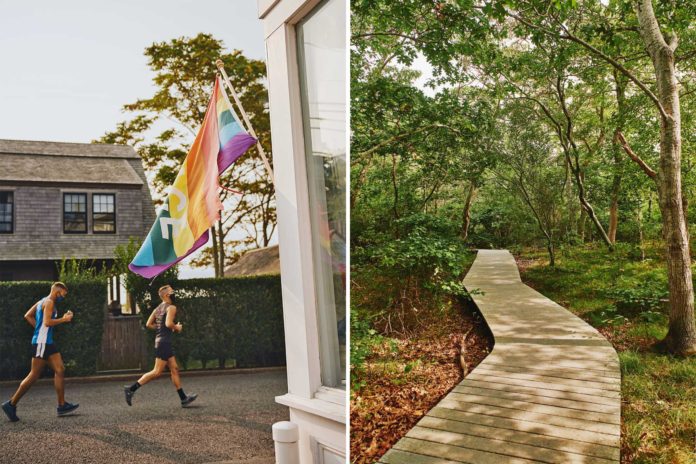I hadn’t spent much time in Provincetown, Massachusetts, before last summer, but I had been given to understand that it’s a place not entirely like the rest of Cape Cod. If Cape Cod is beach-club conservatism and navy-blue-striped American prep, Provincetown is glitter and magic, poets and painters and queens—or so the hearsay went.
My partner, Lora-Faye, and I arrived by car and were greeted not by glitter, but by a warren of narrow lanes lined with tidy houses and gardens bursting with spectacular beds of flowers. Through these lanes strolled men, usually young but sometimes middle-aged or older, walking hand in hand, evidently on their way to the beach or returning to their own hydrangea-thick front yards. Lora-Faye and I live in New York City, where there is no shortage of gay couples, but there was something remarkable about seeing only gay people on a street lined with white picket fences and American flags.
Lora-Faye looked out the windshield, astonished. “What kind of colonial gay Disneyland is this?” she asked.
From left: Staying beach-body fit on Commercial Street; a boardwalk at Cape Cod National Seashore, a reserve surrounding Provincetown. | Credit: Tony Luong
The cognitive dissonance of this sight is central to Provincetown’s overall ethos. Its geography and aesthetics are that of an 18th-century fishing village, but over the past 50 years, it has served as a beacon for the gay community—especially gay men. In the 1980s, this became the rare place where people suffering from HIV/AIDS could live without discrimination and with community support, and it has retained its reputation as a haven. Provincetown is probably the only place I’ve ever been where the roads are given over to elderly lesbians out for a walk and groups of muscled young men in vibrant swimming trunks pedaling toward the beach at a leisurely pace, a portable speaker blasting Whitney Houston’s “I Wanna Dance with Somebody” in the basket of a bicycle.
When it comes to getting around, bicycles, we quickly learned, are the done thing. Pedestrians and cyclists—many of whom take the 90-minute ferry ride from Boston—command the space, making driving a slow and sort of silly venture. This is nice, actually—the relative dearth of cars and the custom of hopping on your bike to go wherever you want makes running around town feel like a reversion to some real or imagined childhood.
We ditched our car as soon as we could and checked in to the Red Inn. This former whaling captain’s house was built in 1805 near the spot where the Pilgrims first docked the Mayflower, and has operated as a hotel since 1915. Our room, which overlooked the beach at Provincetown Harbor, had a deck that hung above the sand and, when the tide came in, above the water.
The custom of hopping on your bike to go wherever you want makes running around town feel like a reversion to some real or imagined childhood.
Lora-Faye and I arrived in the evening with no fixed plans, so we decided to walk around and find something to eat. We had heard that Sal’s Place, a homey Italian restaurant on the beach, was so popular that we would be unlikely to get a table. We stopped by anyway, and got lucky. It was our loveliest evening in town. The host walked us behind the building, where the staff had jammed wooden tables into the sand at the water’s edge, and brought us successively more delicious plates of food: burrata and corn salad, a Caesar with shaved cauliflower, a perfect bowl of linguine with fresh clams.
As we ate, the sun went down and the tide rose. The diners sitting closest to the water kept moving their tables back or abandoning them—by the time we were done with our pasta, the water was lapping at our ankles and we’d perched our shoes next to us on our chairs. Eventually, we too ditched our table, and the waiter invited us to bring our glasses of wine back up to the deck, where we sat happily, barefoot, amid the bustle of the staff, who were cheerfully carrying tables out of the water’s reach.
Afterward we decided to continue our walk through town, which was by then dark and quiet, and scented with those extravagant front-garden flowers. Because much of Provincetown’s architecture dates back to the 17th and 18th centuries, the buildings and streets aren’t quite what we now think of as life-size. They were built for a population that was a few inches shorter, on average, than modern Americans, which gives the place a slightly fantastical aspect, as if it were a fairy village or a movie set.
The town is miraculously free of mosquitoes, which adds to the sense that it is a charmed place, exempt from the banal irritants of normal life, like bugs or homophobia. The streets had the hushed quality of small towns after hours in summer, when the air is so thick and warm it seems to have sound-dampening qualities. Friends called to each other from bicycles or stopped to chat across garden fences. Most people seemed to know most people.
From left: Sal’s Place, a beloved beachside Italian restaurant; seasonal cocktails at Strangers & Saints. | Credit: Tony Luong
This was not a typical summer evening in Provincetown. In August, during a normal year, the town sees 60,000 visitors a day—a fact that, considering its size and infrastructure, seems flat out impossible. Those weeks are Carnivalesque: people come from all over the world for drag shows and queer dance parties, clubbing, parades, costumes, and raucousness. All of this was impossible under pandemic conditions.
When we were there, the clubs were closed, and the famous tea dance at the Boatslip had been postponed until 2021. Restaurants and bars were only serving outside, and just a few of the veteran performers (Miss Richfield 1981, Varla Jean Merman) were still doing their acts—on outdoor stages. The streets, normally shoulder-to-shoulder with visitors, were relatively subdued, and a team of “community ambassadors” wearing red pageant sashes reminded folks to keep their masks on.
It was all extremely pleasant, even with the masks and the odd dance of maintaining six feet from everyone. We wandered the shops and galleries displaying the work of the generations of painters who have come to the Provincetown Art Colony. (The oldest in the country, it has played host to Jackson Pollock, Helen Frankenthaler, Robert Motherwell, and others.) One afternoon, we dropped by the Lobster Pot, a favorite seafood spot, for a peculiar-sounding but mouthwatering buffalo-shrimp roll, and another day we ate at the Canteen, which serves fat lobster rolls at picnic tables in its pleasant backyard.
The Lobster Pot, a 43-year-old Provincetown favorite. | Credit: Tony Luong
Many of the area staples were still humming: the Atlantic House, one of the oldest dives in town (and one of a few establishments open through the desolate winter months), was still serving pints and peanut butter and jelly sandwiches on its porch, and the tiny History of Sex Museum at the front of the sex shop Toys of Eros still had its merkins and vintage vibrators on display. The Provincetown Portuguese Bakery continued to crank out plain-looking but miraculously textured malasadas.
There is a real wildness to the landscapes around Provincetown, which seemed to come into sharper relief in the absence of crowds or nightlife.
Provincetown is also a writer’s town—it has been home to Eugene O’Neill, Norman Mailer, Mary Oliver, Mark Doty, and many more—and we made several trips to Tim’s Used Books, a dreamy little cottage on Commercial Street piled with an excellent selection of secondhand volumes and rare editions. It is run by Tim Barry, who has been in Provincetown since the 1990s and who told us that it was basically unchanged except for the influx of millionaires, who have scooped up the historic real estate over time, charmed by the beaches and the town’s quirky serenity.
From left: Wild grasses at Cape Cod National Seashore; cauliflower Caesar salad at Sal’s Place. | Credit: Tony Luong
We started each day by drinking coffee on the deck of our room at the Red Inn and marveling at the tides, which are unusually dramatic because the beach in Provincetown is so shallow. At low tide, the ocean withdraws and leaves the sand lacquered as far as the eye can see. Slowly, then, the water returns, like creeping lace, until the beach disappears. This was the point at which we would grab our swimsuits and bicycles and pick up breakfast from Relish, a bakery on a residential corner of Commercial Street that was taking telephone orders and handing paper bags full of croissants and egg sandwiches out of its screen door.
Several times we wound up eating on the causeway, a giant rock breakwater that stretches from Pilgrim’s First Landing Park across to Long Point. The lee side, a few locals told us, is the best spot for swimming; the sunny rocks were a good place for picnicking and watching birds eat clams and people picking their way carefully along the stone path to Long Point Beach.
There is a real wildness to the landscapes around Provincetown, which seemed to come into sharper relief in the absence of crowds or nightlife. One afternoon, we took a spectacular bike ride along the trails that trace the protected marine lands outside town. Our route took us through a wilderness of dunes, ponds, tall grasses, and a hidden forest of beech trees. Out in the dunes, too far off the path for us to see, are shacks that were originally built for shipwrecked sailors who had washed up on shore and that the artists’ colony has turned into studios.
A stretch of the 21-mile coastline that envelops the town. | Credit: Tony Luong
Another afternoon we took the long way to Herring Cove Beach, which involved walking three-quarters of a mile through a wide lagoon bed and wading at points. As we followed the footsteps of several young men ahead of us, we didn’t realize that the tide was coming in. Suddenly, the ocean was flooding steadily in our direction, and by the time we turned back the paths were underwater. The terrain, which we’d been mapping by dunes and footprints, was unfamiliar. Up to our shins in water, we ran into a large coyote on a sand bank, who had squared off in front of her three pups. She tracked us as we retreated carefully to the ocean and walked back to our bikes.
“The lunar stillness that pervades out there is difficult to describe. It involves a repose that is pleasurable without being exactly comforting,” Michael Cunningham writes in his book Land’s End: A Walk in Provincetown. This seems to be the town’s favorite text, so ubiquitous that I was, initially, stubbornly reluctant to read it. This obstinate streak usually ensures that I’m pointlessly late to something wonderful. Cunningham’s book is wonderful. In the landscape, Cunningham writes, “you feel as if you are in the eye of something. You are aware—I am aware, anyway—of the world as a place that doesn’t know or care that it’s beautiful…it lives according to geological time.”
From left: The sitting room at the Mary Heaton Vorse house; malasadas, a fried dough specialty made at the Provincetown Portuguese Bakery. | Credit: Tony Luong
The person who finally convinced me to read Land’s End was Ken Fulk, the celebrity interior designer who has recently taken over the Mary Heaton Vorse house, an important specimen of local history. Vorse was a writer and labor journalist who made Provincetown her home in 1907 and was at the center of the town’s transition from a whaling port to a hub for the creative avant-garde. She died in 1966, leaving the house to her family. A few years ago, her granddaughters sold the house to Fulk and his husband, Kurt Wootton, who set about restoring the property and offering it to the community as an artists’ residence, exhibition space, and center for lectures, fundraisers, and other cultural events. (Their own house is across the street.)
Fulk, who is an enthusiastic champion of both Provincetown and Vorse, walked Lora-Faye and me around the house, extolling the virtues of a town that has survived on its quirkiness and scrappiness, its embrace of outsiders and free self-expression. He read to us from Vorse’s memoir of her life in Provincetown, Time and the Town:
“It is not quaint. It is a serious town; the way it is built has to do with the difficult and dangerous manner in which its living has always been earned…. People here have been nourished by beauty and change and danger.”
From left: Rainbow style on Commercial Street; picnic provisions at Angel Foods. | Credit: Tony Luong
Its earliest industries, fishing and whaling, were precarious, Fulk pointed out, and its later residents were experimental artists and outcasts. It has survived more than one plague. At various points in history there has been concern that the town would be overtaken by migrating dunes.
Some of these edges have been softened: the primary industry is now tourism instead of whaling; the town’s gay culture feels squarely mainstream and commercialized. (Ryan Murphy has a house here.) Nevertheless, there remains an oddball, edge-of-the-world charm. After leaving the Mary Heaton Vorse house, we stopped across the street at Angel Foods, a winsome little grocery that’s been there for decades, and bought a jar of pickles for no other reason than that they had a picture of the maker on the lid, a giant kosher pickle cocked jauntily between his teeth.
Even last summer, during a time of uncertainty and loss, Provincetown retained its knack for dancing in the face of hardship and, like the queer community it champions, meeting existential threats with a defiant insistence on pleasure and joy.
After the Puritans displaced and decimated the Nauset people who had lived on the land, Provincetown became the domain of Portuguese fishermen and whalers, who enjoyed humor and dancing, and are credited for the fact that the town is less conservative than the rest of Cape Cod. Even last summer, during a time of uncertainty and loss, Provincetown retained its knack for dancing in the face of hardship and, like the queer community it champions, meeting existential threats with a defiant insistence on pleasure and joy.
On our last afternoon we returned our bicycles and walked back to our car through the quiet streets. From somewhere we could hear a man’s voice singing: “Ooh, life is juicy, juicy, and you see I’ve gotta have my bite, sir.” It was the Barbra Streisand classic “Don’t Rain on My Parade.” We could hear the man belting it out all the way down the block, maybe singing in the shower, maybe rehearsing for a cabaret act that he would perform masked and at a distance. “I simply gotta march, my heart’s a drummer! Nobody, no, nobody is gonna rain on my parade.”
Plan the Perfect Provincetown Trip
Where to Stay
The Red Inn: An old whaling captain’s house converted into an eight-room inn with antique furnishings and a beachfront restaurant. Doubles from $345.
Where to Eat
Angel Foods: This small grocery is the best place to pick up picnic provisions.
The Canteen: Lobster rolls and other high-end lunchtime fare. entrées $8–$22.
Relish: This popular breakfast spot, known for its baked goods, sells a great egg sandwich.
Sal’s Place: A local favorite serving seafood and housemade pastas. Entrées $23–$39.
Strangers & Saints: Inventive New American food (plus excellent cocktails) served in a scenic backyard. Entrées $18–$34.
Where to Shop
Outermost: One-of-a-kind artworks, pottery, wooden bowls, and handmade furniture.
Respoke: Handcrafted espadrilles and accessories made from vintage silk scarves.
Tim’s Used Books: A well-curated collection in a cottage set back from Commercial Street. 242 Commercial St.; 508-487-0005.
Toys of Eros: An exuberant, LGBTQ friendly spot that carries adult toys.
What to Do
A version of this story first appeared in the June 2021 issue of Travel + Leisure under the headline Small Town, Big Heart.







